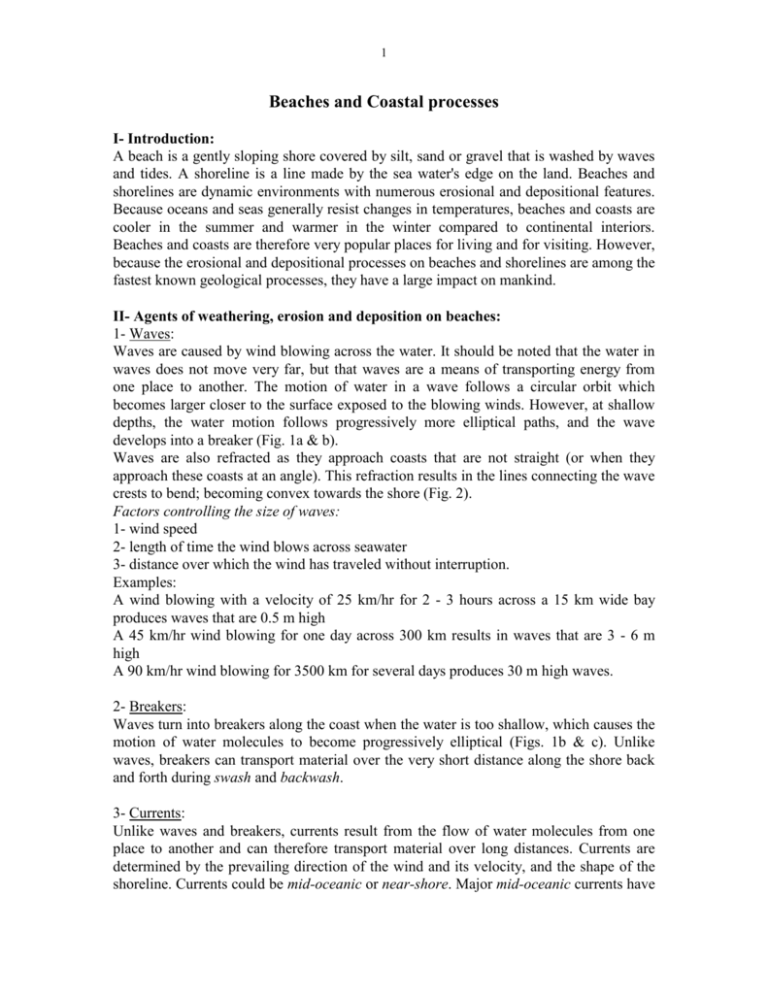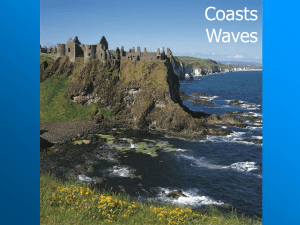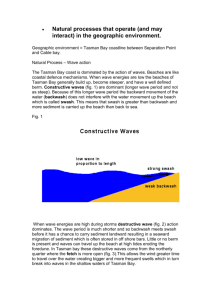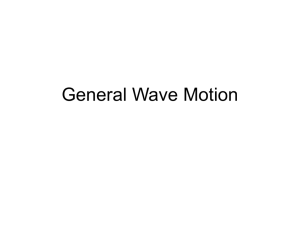Beaches and Coastal processes
advertisement

1 Beaches and Coastal processes I- Introduction: A beach is a gently sloping shore covered by silt, sand or gravel that is washed by waves and tides. A shoreline is a line made by the sea water's edge on the land. Beaches and shorelines are dynamic environments with numerous erosional and depositional features. Because oceans and seas generally resist changes in temperatures, beaches and coasts are cooler in the summer and warmer in the winter compared to continental interiors. Beaches and coasts are therefore very popular places for living and for visiting. However, because the erosional and depositional processes on beaches and shorelines are among the fastest known geological processes, they have a large impact on mankind. II- Agents of weathering, erosion and deposition on beaches: 1- Waves: Waves are caused by wind blowing across the water. It should be noted that the water in waves does not move very far, but that waves are a means of transporting energy from one place to another. The motion of water in a wave follows a circular orbit which becomes larger closer to the surface exposed to the blowing winds. However, at shallow depths, the water motion follows progressively more elliptical paths, and the wave develops into a breaker (Fig. 1a & b). Waves are also refracted as they approach coasts that are not straight (or when they approach these coasts at an angle). This refraction results in the lines connecting the wave crests to bend; becoming convex towards the shore (Fig. 2). Factors controlling the size of waves: 1- wind speed 2- length of time the wind blows across seawater 3- distance over which the wind has traveled without interruption. Examples: A wind blowing with a velocity of 25 km/hr for 2 - 3 hours across a 15 km wide bay produces waves that are 0.5 m high A 45 km/hr wind blowing for one day across 300 km results in waves that are 3 - 6 m high A 90 km/hr wind blowing for 3500 km for several days produces 30 m high waves. 2- Breakers: Waves turn into breakers along the coast when the water is too shallow, which causes the motion of water molecules to become progressively elliptical (Figs. 1b & c). Unlike waves, breakers can transport material over the very short distance along the shore back and forth during swash and backwash. 3- Currents: Unlike waves and breakers, currents result from the flow of water molecules from one place to another and can therefore transport material over long distances. Currents are determined by the prevailing direction of the wind and its velocity, and the shape of the shoreline. Currents could be mid-oceanic or near-shore. Major mid-oceanic currents have 2 certain predictable flow directions (Fig. 3) controlled by the combined action of wind blowing from areas of high atmospheric pressure to those of low atmospheric pressure, and the rotation of the earth around itself; a phenomenon known as the Coriolis effect (Fig. 4). Currents that occur near shores include: (a) longshore currents which flow and transport sediments parallel to the coast and which result from the waves approaching the shore at an angle (Fig. 5), and (b) Rip or undertow currents in which water flows back to the sea or ocean after the waves break on the shore (Fig. 6). 4- Tides: Tides are broad regional variations in water level caused primarily by the gravitational pull of the sun and moon on the earth's water bodies. Therefore, unlike waves which rise and fall in seconds, tides rise and fall in hours. Types: 1- Spring tide: Sun and moon on the same line (Fig. 7a) 2- Neap tide: Sun and moon at right angles to each other (Fig. 7b). 5- Surges: Result from severe storms, and rise and fall over a time period in between that for tides and that for waves. III- The Beach Profile: Not all beaches have the same profile. The profile depends on the amount of sediment eroded and that deposited on the beach as well as a number of other factors. Figure 8 shows a typical beach profile consisting of: A- The coast; possibly with coastal cliffs. B- The backshore C- The Foreshore or intertidal zone D- The offshore IV- Erosional and depositional features of beaches and coasts Beaches predominated by erosional processes are ones that are regularly pounded by waves, and are thus characterized by a shoreline that migrates landward. These beaches are therefore described as submergent beaches. On the other hand, beaches in which depositional rates exceed the rates of erosion are described as emergent beaches, as their shorelines appear to retreat in the seaward direction. A- Erosional features: 1- Wave cut cliff 2- Wave cut platform: Is an almost flat or very gently sloping surface eroded by the constant action of the waves, and may extend beyond the high tide limit as it forms by the combined action of tides and surges (Fig. 8). Note that if a beach becomes emergent due to sea level fall or uplift of the land, the wave cut platform rises above sea level and is no longer subjected to the action of waves, tides and surges. This platform therefore becomes a wave cut terrace (Fig. 9), as the waves and tides carve up a new wave cut platform on the seaward side. 3 3- Sea caves 4- Sea arches: (Fig. 10) 5- Stacks: (Fig. 10) 6- Estuaries: Estuaries are not really erosional features, but they tend to be more common in submergent beaches, where seawater is driven into the mouth of a river during periods of high tide, making the water there brackish. B- Depositional features: Beach sediments are either brought by ocean currents and deposited by waves or longshore currents, or are derived from the land and carried and deposited by rivers and winds. 1- Berms: Are wave deposited platforms that form in the backshore area and slope gently in the landward direction. 2- Spits and sand bars: A spit is a finger-like ridge of sediment that extends out into open water (Fig. 11). Spits form mainly by the action of longshore currents which deposit their load parallel to the shore when they lose their energy. 3- Tombolos: A tombolo is a strip of sediment connecting what used to be an island to the mainland. It is therefore formed by the combined action of longshore drift and waves as they are refracted by this island, causing sediments to deposit behind this island (Fig. 12). 4- Barrier island: Are long, narrow islands parallel to the coast (Fig. 13). Their exact mode of formation is not well understood. 5- Baymouth bar: Is a ridge of sediment that cuts the bay off from the ocean (Fig. 11). V- Sea level changes and their causes Regression and transgression. Eustatic changes. Role of ice caps and ice sheets. The greenhouse effect and its anticipated role in sea level rise. Present-day rate of sea level rise ~ 0.3 m/100 years. VI- The effects of coastal erosion and attempts at reducing them Rates of coastal erosion: average rate of erosion on the Atlantic coast of USA is 0.5 - 2 m/year, reaching up to 20 m/year in some areas! Building groins and breakwaters to control longshore drift (Fig. 15). The use of rip-rap Reclamation of land from the sea





